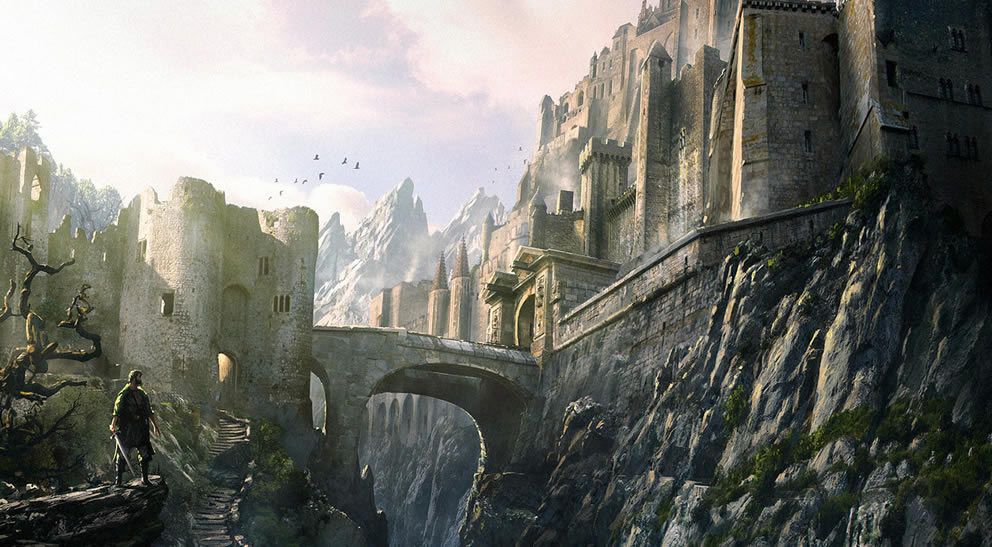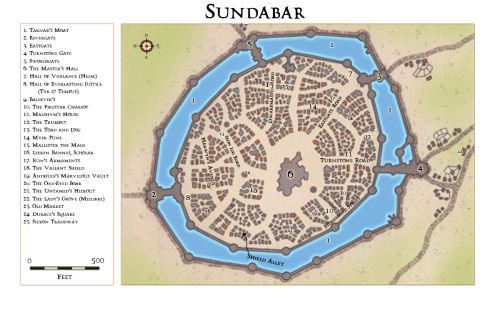Sundabar
The Sundabarans were a vigilant, wary, people, as life in the north demanded. Outsiders, enthusiastic passers-by and people who simply asked too many questions were looked at with suspicion and apprehension within the city.
Layout
Sundabar was a fortress. Its harsh and treeless surface was surrounded by two ringed walls, surrounded by Tarnar's Moat, a water-filled trench that was rumored to be filled with man-eating eels.Within its walls, Sundabar's massive stone buildings were encircled by cobblestone streets, with no flora to be found save for the sparse window-box garden of fragrant herbs. Four gates and bridges led into the city: Swordsgate in the north, Eastgate in the northeast, Turnstone Gate in the southeast and Rivergate in the west. Beneath Sundabar was a volcano rift known as the Everfire. Connected to the surface by a steep passage, the Undercity was home to most of the dwarven population.Government
The Ruling Master served as the ultimate leader of the city. However, the Forgemaster served as the leader of the dwarven community and was an important adviser to the Ruling Master.Adventuring charters
The government office of Sundabar maintained a standing list of jobs they needed to have completed and would hire adventuring companies to this end. The adventurers were granted a city charter, which granted them limited authority to complete their specified task. This charter was to be made available to any city official upon demand. Pay for these jobs varied, depending on what was needed, the time of year and whether the task involved a significant threat to the city. Fewer adventurers and increasingly dangerous weather in the winter led to more gold for the hired swords. However, the charters came with a provision that 10% of the value of any loot or valuables gathered by adventurers during their contract, be contributed to Sundabar as a fee for being granted a contract.Economy
The city was a trading hub for ore from Citadel Adbar and the dwarves of Fardrimm. It was also the source of magical weapons enchanted by the Everfire volcano. Due to the access of such unique resources, Sundabar's coffers were often quite full, and allowed them to be more indulgent when it came to defense or other needs. Furthermore, the city was well-stocked, with larders that could feed the city for months, and had a protected source of fresh well water from the subterranean Lake Anfarra.Defense
In addition to their structural defenses the city was protected by a number of groups and organizations: Stone Shields: Sundabar's city watch; led by the Watchblade, who often received magical assistance from the local clerics of Helm or Tyr. Watchful: A network of spies also under command of the Watchblade. Shieldsar: Sundabar's main defense were the ~2000-strong riders, infantry and archers who patrolled the Sundabar Vale in defense of their city. Vigilant: An elite group of dwarven warriors that constantly stood guard at the Everfire. Under the reign of Helm Dwarf-Friend, taxes from the Sundabarans were used the proceeds to shore up Sundabar's defenses against orc attacks, which had become a regular occurrence during those years. The deep treasury of the city helped keep both adventuring companies, as well as hardened mercenaries on retainer. This latter group, who also just happened to be old friends of one Helm Dwarf-Friend, were known as the Bloodaxe Mercenary Company. Sundabar could also count on allies from the region of the Underdark located under the lands between the North and the Anauroch desert known as the Fardrimm.Geography
Sundabar was located in Sundabar Vale on the eastern side of Silverymoon Pass, with the Nether Mountains making up the southern border of the valley. The Rauvin Mountains and Citadel Felbarr were upriver on the River Redrun, Rauvincross downriver, Baraskur to the east, and Auvandell in the western slopes of the Nether Mountains. Sundabar was directly connected to Citadel Adbar by the Dead Orc Pass, but only the most daring (or foolish) of travelers took that route. Sundabar was connected to Silverymoon via the road that ran through Silverymoon Pass. The road was well patrolled, but it was often impassable in winter due to avalanches. The Hawk's Nest watchtower at the top of the pass was manned by a dozen Knights in Silver and provided a place for travelers to rest in safety. The entire journey took between one and two tendays, with the distance making up nearly 150 miles.Notable locations
Landmarks
The Circle: A large square in the center of the city that housed market stalls and caravans. In the center of the Circle was the Master's Hall. Everfire: a volanic rift deep beneath Sundabar, fueling the forges of the undercity. Master's Hall: Crowded group of towers and battlements that houses the city's government. It is located at the very center of the city on the Circle. Undercity: The original Dwarven Hall, where most of the Dwarven population lives and works.Temples
Hall of Everlasting Justice: Temple of Tyr and Torm. Overseen by Defender of Justice Lathkiera Morlund. Hall of Vigilance: Temple of Helm. Overseen by Winterlord Senior Steeleye Mraskin. Located close to the Eastgate. Temple of the Morndinsamman: Temple to the Dwarven pantheon, overseen by Baeradun Longbeard. Located in the undercity.Inns
Baldiver's: Similar in appearance to an old castle, this quiet, spacious inn catered to the older, quieter clientele of the city. Firestar Chariot: This lively inn, which featured loud music and furnishings, was quite popular among Sundabar's younger bar patrons. Malshym's House: A clean, quiet inn whose no-nonsense aesthetic made it popular with traveling merchants. The Trumpet: Luxurious and expensive, this discreet establishment was home to a number of adventuring companies.Taverns
Halabar's Horn of Spirits: A filthy dive on Lanthalar street whose patrons stumbled and fought out into the streets. Maiden at Midnight: This rather famous festhall was the only of its kind within the Circle of Sundabar. The Maiden featured the often-favorite "trapdoor room" within its cellar. Sighing Sylph: A quiet, fairly indistinguishable bar for the locals who lived on Northwind street. Tabbard & Tankard: Similarly unremarkable as the Sylph, this tavern had the dubious distinction of being fairly overpriced. Unshimble's Ugly Face: A rowdy tavern named after the gigantic signboard of a goblin's head that adorned its entrance.Shops
Sundabar featured some of the finest craftsmen of both the North, and all of Faerûn. Among these were master carpenters, wheelwrights and of course, blacksmiths. The city housed the following shops: Blackraven Wagons, Doors, and Shutters • Feldar's Wheels and Wagons • Furjur's Flying Carpet • Gullaxe's Stairs, Rails, Poles, Staves and Handles • Hammerlar's Fine Floors and Housework • Krystryn's Shelves • Larantarn's Chairs and Stools • The Lutery • Mith's Carved Whimsies and Woodcuts • Naeth's Nails, Pegs, Locks, and Other Woodfinery • Old Anvil Smithy • Old Block • Old Fireblower Pouch & Pipe Shop • Old Ornar's Beds and Tables • Shyndle's Lutes & Pipes • Thimm's Shingles, Shakes, and Finefinish TabletopsHistory
Sundabar was originally Citadel Sundbarr, a primarily subterranean dwarven citadel of the Delzoun empire, built around the year -500 DR. The hold garnered its strength from massive foundries built around the underground inferno known as the Everfire. The citadel's most skilled metalworkers and forgers could craft massive works and work with alloys that were typically too volatile without such intense heat. In the Year of the Black Unicorn, as the great underground northkingdom of Delzoun fell around them, Citadel Sundbarr was saved by the ingenuity of its master forgers. They created a massive, molten wall that protected the dwarven stronghold. Over the years to follow, however, Sundabar's influence and strength waned as its population lessened. In 329 DR, the surface fortress was assaulted and plundered by orcs. Continued monster attacks would plague the city for over the next 500 years, though it never fully succumbed to the onslaught. In 882 DR, one of the High Captains of Ascalhorn, Prince Simberuel Astalmé, fled his city with a group of refugees to Sundabar Vale, pursued by vrocks. The refugees were saved at the last minute by the Forgemaster of Sundbarr. Astalmé gave his life to save the Forgemaster, and in return, the humans were allowed to settle in the abandoned surface portion of Citadel Sundbarr.A city reborn
The next 500 years would be much more fortuitous for the citadel. As the new human inhabitants settled in and united with their dwarven brethren, the reconstruction of the stronghold led to the birth of a new city. As dwarven craftsmanship became perfectly interwoven with human mercantilism, the newly-named Sundabar flourished into the symbol of strength it would become in the North. In the 13th century DR, the foundries and workshop closest to the Everfire rift were destroyed by a surge of fire and never repaired. Since then, the fires burned without any control by the dwarves. In 1355 DR, Helm Dwarf-Friend became the sixth Ruling Master of Sundabar after the previous Master died defending the city from orcs. In 1369 DR, fiends from Hellgate Keep attacked Sundabar, burning much of the city before being forced out. Just four years later, in 1373 DR, Kaanyr Vhok attempted to take control of the city because of a rivalry he had with Helm Dwarf-Friend. He first used Aliisza to infiltrate Helm Dwarf-Friend's house, then allied with Zasian Menz and Banite priests. His plan ultimately failed. In 1369 DR, Sundabar was one of the city-states to join together in the League of the Silver Marches, later renamed "Luruar", alongside Silverymoon, Citadel Adbar, Deadsnows, Jalanthar, Quaervarr, Citadel Felbarr, Everlund, and Mithral Hall. The goal of the alliance was to protect the North from the growing hordes of orcs in the mountains. In 1488 during the War of the Silver Marches Sundabar was conquered by an orc army commanded by the warlord Hartusk and renamed Hartusk Keep. The survivors retreated into the undercity and lived in seclusion for ten years, until a mercenary company drove the orcs from Sundabar and rescued the survivors in 1498 DR. Sundabar struggled to return to its former glory. In 1536, following the defeat of the League of the Silver Marches, Sundabar came to be the only provider of Dwarven wares in the region. Trade boomed, but the city also came to be the sole protector of the eastern Silver Marches. Without the support of the Knights in Silver, protection of the region from the orc hordes of the north fell on Sundabar and the Dwarves of the fardrimm. Facing orc attacks from the north and Drow and Duergar raiding parties from the underdark, Sundabar came to rely even more on Mercenary Companies and adventurers for defense. Rumors of strange creatures from the underdark abound, and patrols have been going missing at an increasing rate. In 1587 DR, the city was destroyed when the shade enclave Gloomwrought fell atop it after the Lord of Shade's defeat.
Government: Ruling master, forgemaster
Ruler: Ruling Master Eomund Dwarf-Friend. Forgemaster Agni Firebeard.
Size: City
Population: ~15,000
Economy: Armor, clay wares, copper, furniture, gold, lumber, pelts, silver, tools, weapons
Races:
Humans 54%
Dwarves 33%
Gnomes 8%
Halflings 8%
Half-elves 1%
Others 1%



Comments